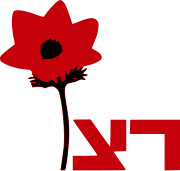Ratz (political party)
Movement for Civil Rights and Peace התנועה לזכויות האזרח ולשלום | |
|---|---|
 | |
| Leader | Shulamit Aloni Yossi Sarid Gabi Deus (de jure) |
| Founded | 1973 |
| Dissolved | 1997 (de facto) |
| Split from | Alignment |
| Merged into | Meretz |
| Ideology | Liberal socialism[1][2] Civil libertarianism[3] Secularism Anti-clericalism[4] Green politics[5] Socialist feminism Two-state solution Labor Zionism |
| Political position | Left-wing[6] |
| Most MKs | 6 (1992) |
| Election symbol | |
| רצ | |
Ratz (
History
The Movement for Civil Rights and Peace was formed in 1973 by
In its first test, the 1973 elections, the party won 2.2% of the vote and three seats in the Knesset, which were taken by Aloni, new American immigrant Marcia Freedman, and Boaz Moav. The party soon gained the popular name Ratz, as it used the letters Resh-Tzadik on the election ballot paper. Following Golda Meir's resignation, the party joined Yitzhak Rabin's government and Aloni served as a minister without portfolio. This was one of the few periods in Israel's political history when no religious parties were part of the coalition. The arrangement lasted for a few months only and when the National Religious Party joined the coalition, Ratz left it.
In 1975 the party merged with
Ratz performed poorly in the '77 elections, winning only one seat, which Aloni took. The 1981 elections were a repeat, with only Aloni representing the party in the Knesset. During the Knesset session she merged the party into the Alignment, but then broke away again before the term ended.
Before the 1984 elections the Left Camp of Israel merged into Ratz in a one-to-three ratio, bringing with them Ran Cohen among others. The elections were an improvement on the previous two, and saw the party win three seats. During the Knesset session, the party gained another two seats when Yossi Sarid and Mordechai Virshubski joined, defecting from the Alignment and Shinui respectively. The party retained its five-seat strength in the 1988 elections.
Prior to the
Election results
| Election | Leader | Votes | % | Seats | +/– | Status |
|---|---|---|---|---|---|---|
| 1973 | Shulamit Aloni | 35,023 | 2.2 | 3 / 120
|
New | Opposition (1973–1974) |
| Government (1974) | ||||||
| Opposition (1974-1977) | ||||||
| 1977 | 20,621 | 1.2 | 1 / 120
|
Opposition | ||
| 1981 | 27,921 | 1.4 | 1 / 120
|
Opposition | ||
| 1984 | 49,698 | 2.4 | 3 / 120
|
Opposition | ||
| 1988 | 97,513 | 4.3 | 5 / 120
|
Opposition | ||
| 1992 | Part of Meretz | 6 / 120
|
Government | |||
1996
|
Yossi Sarid | 4 / 120
|
Opposition | |||
Knesset members
| Knesset (MKs) |
Knesset Members |
|---|---|
| 8th (3−1) |
Shulamit Aloni, Boaz Moav − Marcia Freedman (to the Social-Democratic Faction) |
| 9th (1) |
Shulamit Aloni |
| 10th (1) |
Shulamit Aloni |
| 11th (3+2) |
Shulamit Aloni, ) |
| 12th (5) |
Shulamit Aloni, Ran Cohen, Yossi Sarid, Mordechai Virshubski, David Zucker |
| 13th (6 out of 12) |
Shulamit Aloni, Ran Cohen, David Zucker, Yossi Sarid, Naomi Chazan, Binyamin Temkin |
14th (4 out of 9) |
Yossi Sarid, Ran Cohen, David Zucker, Naomi Chazan |
References
- ^ "The Left". The Jerusalem Post. 1999. Retrieved 21 June 2015.
- ISBN 9780739133613. Retrieved 21 June 2015.
- ISBN 9780810864030. Retrieved 21 June 2015.
- ISBN 978-0720122367.
CIVIL RIGHTS MOVEMENT (Rotz). This radical, dovish, and anticlerical party was founded in 1973 by Shulamit Aloni, a noted civil rights activist, who failed to win renomination on the Labor Party* ticket.
- ISBN 978-0814323977.
In terms of social and economic policy, Labor is a social democratic party; Mapam, the old socialist left; CRM is an Israeli-style Green party; and Shinui is what Terry Clark has described as Neo-Populist—fiscally conservative and liberal on life-style issues.
- ISBN 978-1-317-58450-6.
- ISBN 9780874519624. Retrieved 21 June 2015.
- ^ "Domestic politics in Israeli peace-making, 1988-1994" (PDF). Archived from the original (PDF) on 18 May 2015.
- ISBN 0792306856.
Hatnua Lezlmiot Haezrah (the Civil Rights Movement, or CRM) is primarily interested in protecting the secular character of the State of Israel and the civil rights of its citizens. The CRM advocates a liberal economic policy and a dovish stand in the Israeli-Arab conflict.
External links
- Party history Knesset website
